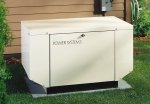Search engine visitors - click here to access entire "$ensible Home" web site
Click here to see a descriptive illustration of several automatic emergency generator systems
Dear Jim: There are occasional electrical power outages in my area, so I thought about getting an automatic whole-house emergency generator. Are they expensive to operate and can they really power an entire house? - Pam A.

A: Whole-house standby generators are becoming much more popular because of the many electrical devices used in homes today. It can often be difficult for a family to get by without electricity for even a short time.
If electrical power outages occur during a storm as they often do, and your house has a sump pump, serious flooding can result. If you are away from home and your lights and security system don't function because of a power outage, your house is easy prey for thieves or vandals.
Although you can install a manual transfer switch to switch over to the standby generator, most whole-house standby generators use an automatic transfer switch. When the electricity goes off, it automatically disconnects your house from the power grid and starts the generator.
Most models restore full electric power to your house in about 10 seconds. About all you will have to do is reset your digital clocks. The automatic transfer switch also "exercises" the motor and generator every week or two to make sure it is in good working condition when needed.
For most homes, a 10- to 15-kw (kilowatt) output standby generator will provide adequate power. Most models in this residential-size range are powered by natural gas or propane and are relatively efficient and inexpensive to operate. Models with diesel engines are also available.
Models that run on natural gas or propane have a small one- or two-cylinder engine inside. Running on these very clean burning fuels requires very little maintenance other than a spark plug or oil change every 100 hours of operation or so. The propane models are slightly more powerful.
Most standby generators are about the size of a typical central air conditioner outdoor unit and are located near a house wall. The small gas or propane engines operate very quietly. The automatic transfer switch is usually located on the wall near your circuit breaker panel indoors.
A less expensive emergency generator option is a portable gasoline-powered model. Some of them have outputs as high as 6 kw, so they can easily power most of your family's essential needs. These normally use a manual transfer switch, so you must start the engine and throw the switch yourself.
With small portable generators, appliances are often plugged into the generator with extension cords. If any generator is attached to the house wiring, a transfer switch is needed to protect the utility company's workmen.
Instant Download Update Bulletin No. 605 - buyer's guide of eight automatic whole-house and portable emergency generator manufacturers (30 models) listing, electricity outputs, fuels (natural gas, propane, gasoline), features, prices, wattage charts for home appliances and portable electric tools, operation and installation instructions.
Dear Jim: I have a triple-track storm/screen door over my back door. I pulled out the glass and screen panels to clean them. How can I tell what is the proper way to position them back in the tracks? - Lois H.
A: Not all triple-track storm doors are the same, but in general, you can match up the panels with the width of the tracks. The track on the outdoor side is usually the smallest and the indoor one is the widest. The latches usually go to the bottom.
Also check the positioning of the weatherstripping between the panels. When installed properly in the door frame, the weatherstripping should seal all gaps between the panels.